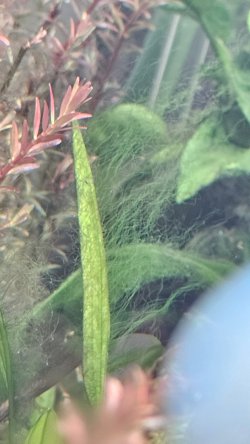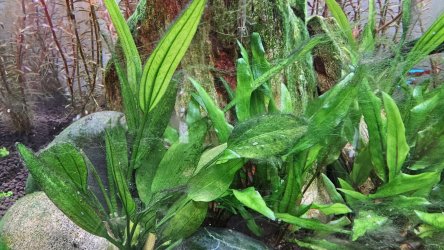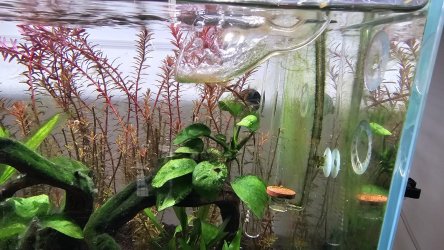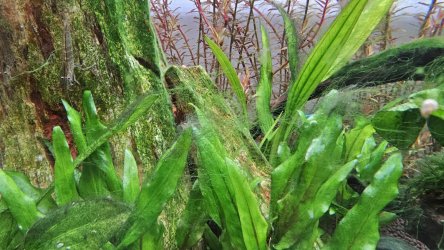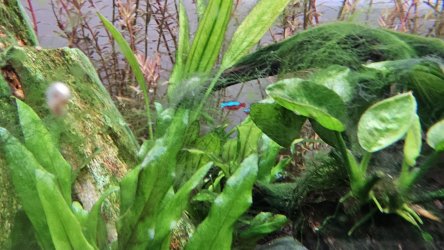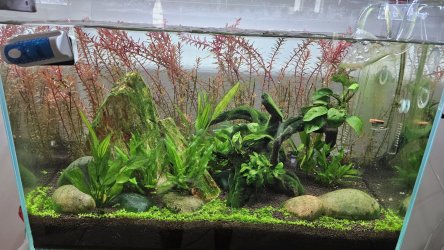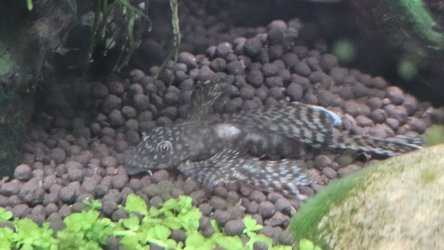🌟 Exclusive Amazon Black Friday Deals 2024 🌟
Don’t miss out on the best deals of the season! Shop now 🎁
You are using an out of date browser. It may not display this or other websites correctly.
You should upgrade or use an alternative browser.
You should upgrade or use an alternative browser.
Algae Infestation in Cycled Tank
- Thread starter vskscaper
- Start date
Need pictures of dead fish and live fish to check for diseases.
Basic first aid for fish.
Test the water for ammonia, nitrite, nitrate and pH. Post results in numbers here.
Wipe the inside of the glass down with a clean fish sponge. This removes the biofilm on the glass and the biofilm will contain lots of harmful bacteria, fungus, protozoans and various other microscopic life forms.
Do a 75% water change and gravel clean the substrate every day for a week or until the problem is identified. The water changes and gravel cleaning will reduce the number of disease organisms in the water and provide a cleaner environment for the fish to recover in. It also removes a lot of the gunk and this means any medication can work on treating the fish instead of being wasted killing the pathogens in the gunk.
Make sure any new water is free of chlorine/ chloramine before it is added to the tank.
Clean the filter if it hasn't been done in the last 2 weeks. However, if the filter is less than 6 weeks old, do not clean it. Wash the filter materials/ media in a bucket of tank water and re-use the media. Tip the bucket of dirty water on the garden/ lawn. Cleaning the filter means less gunk and cleaner water with fewer pathogens so any medication (if needed) will work more effectively on the fish.
Increase surface turbulence/ aeration to maximise the dissolved oxygen in the water.
Don't add anything to the tank until the problem is identified.
Basic first aid for fish.
Test the water for ammonia, nitrite, nitrate and pH. Post results in numbers here.
Wipe the inside of the glass down with a clean fish sponge. This removes the biofilm on the glass and the biofilm will contain lots of harmful bacteria, fungus, protozoans and various other microscopic life forms.
Do a 75% water change and gravel clean the substrate every day for a week or until the problem is identified. The water changes and gravel cleaning will reduce the number of disease organisms in the water and provide a cleaner environment for the fish to recover in. It also removes a lot of the gunk and this means any medication can work on treating the fish instead of being wasted killing the pathogens in the gunk.
Make sure any new water is free of chlorine/ chloramine before it is added to the tank.
Clean the filter if it hasn't been done in the last 2 weeks. However, if the filter is less than 6 weeks old, do not clean it. Wash the filter materials/ media in a bucket of tank water and re-use the media. Tip the bucket of dirty water on the garden/ lawn. Cleaning the filter means less gunk and cleaner water with fewer pathogens so any medication (if needed) will work more effectively on the fish.
Increase surface turbulence/ aeration to maximise the dissolved oxygen in the water.
Don't add anything to the tank until the problem is identified.
Will try cleaning the tank as you suggested. I will test the water and post results here. Now doing daily 20% water change. Not sure how well I will be able to clean the gravel as the tank is planted.Need pictures of dead fish and live fish to check for diseases.
Basic first aid for fish.
Test the water for ammonia, nitrite, nitrate and pH. Post results in numbers here.
Wipe the inside of the glass down with a clean fish sponge. This removes the biofilm on the glass and the biofilm will contain lots of harmful bacteria, fungus, protozoans and various other microscopic life forms.
Do a 75% water change and gravel clean the substrate every day for a week or until the problem is identified. The water changes and gravel cleaning will reduce the number of disease organisms in the water and provide a cleaner environment for the fish to recover in. It also removes a lot of the gunk and this means any medication can work on treating the fish instead of being wasted killing the pathogens in the gunk.
Make sure any new water is free of chlorine/ chloramine before it is added to the tank.
Clean the filter if it hasn't been done in the last 2 weeks. However, if the filter is less than 6 weeks old, do not clean it. Wash the filter materials/ media in a bucket of tank water and re-use the media. Tip the bucket of dirty water on the garden/ lawn. Cleaning the filter means less gunk and cleaner water with fewer pathogens so any medication (if needed) will work more effectively on the fish.
Increase surface turbulence/ aeration to maximise the dissolved oxygen in the water.
Don't add anything to the tank until the problem is identified.
Why so little?doing daily 20% water change
It's good that you haven't added the algaecide again.
I noticed that you use CO2 (requires a balance of higher light and nutrients) but the replies you had about the algae issues were appropriate to low tech tanks (no CO2, less light, less fertiliser). This advice may have caused plants to die back or reduce growth which could upset the balance. Can you explain you're current set up and maintenance and show a new tank photo?
Yes, I have co2 injection in place. Using a sunson 303B canister filter. Neo Helios Light.Why so little?
It's good that you haven't added the algaecide again.
I noticed that you use CO2 (requires a balance of higher light and nutrients) but the replies you had about the algae issues were appropriate to low tech tanks (no CO2, less light, less fertiliser). This advice may have caused plants to die back or reduce growth which could upset the balance. Can you explain you're current set up and maintenance and show a new tank photo?
I only do water changes in 2 weeks previously. Now I do 20% water change daily. I used to dose fertilizer only when water change was done. Now I have stopped dosing the same. I used to have 8 hours light and co2 on. Now I have reduced the light and co2 duration to 4 hours due to algae issues. Posted some new photos
Attachments
OK, the plant growth isn't bad, only the one on the left has reduced in size.
My thought process was that a reduction in plants and growth had caused ammonia to build which killed the fish. Where plants are doing the majority of the filtering, beneficial bacteria are in low numbers and struggle to take over in time when plants die back.
If you could monitor and post test results for ammonia, nitrite and nitrate it may eliminate this as an issue. Regardless, follow Colin's advice of 75% daily water changes for a week to reduce toxins or pathogens and save the fish.
For the algae, most members here just have low tech tanks (as high tech are tricky!) but I'm tagging @StevenF and @Wills who have a better understanding of balancing a planted CO2 tank. Hopefully they keep an eye on the forums and have time to advise.
My thought process was that a reduction in plants and growth had caused ammonia to build which killed the fish. Where plants are doing the majority of the filtering, beneficial bacteria are in low numbers and struggle to take over in time when plants die back.
If you could monitor and post test results for ammonia, nitrite and nitrate it may eliminate this as an issue. Regardless, follow Colin's advice of 75% daily water changes for a week to reduce toxins or pathogens and save the fish.
For the algae, most members here just have low tech tanks (as high tech are tricky!) but I'm tagging @StevenF and @Wills who have a better understanding of balancing a planted CO2 tank. Hopefully they keep an eye on the forums and have time to advise.
While this comment wont help much.I never had such aquariums, but I participated at troubleshooting some.
High tech planted aquarium are like ballistic missile... Once launched ,You can only destroy them. They go to their destination no matter what.
Avoiding nutrients that build up, to build up... And those who depletes, to deplete, while gauging light as needed. are the sole controls you have.
In my experience, once the balance tilts in favor of algae (they should always be treated as invasive)... There's no plants getting out of there, they are going to turn them into food, when you have 3-4 different assailant, You cant keep the light up without you feeding them first. They are indeed extremely invasive and opportunistic on nutrients.
At this point honestly, With the cost of building such a tank.
I go: Removing, scrubbing, vacuuming, dipping, cutting, pruning. Whatever it takes to have lot more plants than algae at the end.
Biologically, the only way to tilt the balance in the other direction.
A tank can have an apocalyptic look for a while after that kind of intervention and survive, then thrive.
It is possible that dying algae in addition of creating ammonia released diverse products that could be toxic in enclosed environment.
In addition to water changes I would also run a bag of fresh carbon for a while.
High tech planted aquarium are like ballistic missile... Once launched ,You can only destroy them. They go to their destination no matter what.
Avoiding nutrients that build up, to build up... And those who depletes, to deplete, while gauging light as needed. are the sole controls you have.
In my experience, once the balance tilts in favor of algae (they should always be treated as invasive)... There's no plants getting out of there, they are going to turn them into food, when you have 3-4 different assailant, You cant keep the light up without you feeding them first. They are indeed extremely invasive and opportunistic on nutrients.
At this point honestly, With the cost of building such a tank.
I go: Removing, scrubbing, vacuuming, dipping, cutting, pruning. Whatever it takes to have lot more plants than algae at the end.
Biologically, the only way to tilt the balance in the other direction.
A tank can have an apocalyptic look for a while after that kind of intervention and survive, then thrive.
Fish are dying one by one. I have been doing regular water changes. Not sure if the use of APT fix (previously) is causing this. Some dead fishes seem inflamed. Not sure what to do next.
It is possible that dying algae in addition of creating ammonia released diverse products that could be toxic in enclosed environment.
In addition to water changes I would also run a bag of fresh carbon for a while.
I already ha e
I had posted Ammonia results before. There was no Ammonia in the tank. But the Nitrate was high. I will test again and get back.OK, the plant growth isn't bad, only the one on the left has reduced in size.
My thought process was that a reduction in plants and growth had caused ammonia to build which killed the fish. Where plants are doing the majority of the filtering, beneficial bacteria are in low numbers and struggle to take over in time when plants die back.
If you could monitor and post test results for ammonia, nitrite and nitrate it may eliminate this as an issue. Regardless, follow Colin's advice of 75% daily water changes for a week to reduce toxins or pathogens and save the fish.
For the algae, most members here just have low tech tanks (as high tech are tricky!) but I'm tagging @StevenF and @Wills who have a better understanding of balancing a planted CO2 tank. Hopefully they keep an eye on the forums and have time to advise.
The white mark on the bristlenose looks like excess mucous covering an abrasion (small wound). Monitor and post more pictures if it gets worse. In the mean time you can do the following to reduce the chance of infection getting into the wound.
Wipe the inside of the glass down with a clean fish sponge. This removes the biofilm on the glass and the biofilm will contain lots of harmful bacteria, fungus, protozoans and various other microscopic life forms.
Do a 75% water change and gravel clean the substrate every day for a week. The water changes and gravel cleaning will reduce the number of disease organisms in the water and provide a cleaner environment for the fish to recover in. It also removes a lot of the gunk and this means any medication can work on treating the fish instead of being wasted killing the pathogens in the gunk.
Make sure any new water is free of chlorine/ chloramine before it is added to the tank.
Clean the filter if it hasn't been done in the last 2 weeks. However, if the filter is less than 6 weeks old, do not clean it. Wash the filter materials/ media in a bucket of tank water and re-use the media. Tip the bucket of dirty water on the garden/ lawn. Cleaning the filter means less gunk and cleaner water with fewer pathogens so any medication (if needed) will work more effectively on the fish.
Increase surface turbulence/ aeration to maximise the dissolved oxygen in the water.
Wipe the inside of the glass down with a clean fish sponge. This removes the biofilm on the glass and the biofilm will contain lots of harmful bacteria, fungus, protozoans and various other microscopic life forms.
Do a 75% water change and gravel clean the substrate every day for a week. The water changes and gravel cleaning will reduce the number of disease organisms in the water and provide a cleaner environment for the fish to recover in. It also removes a lot of the gunk and this means any medication can work on treating the fish instead of being wasted killing the pathogens in the gunk.
Make sure any new water is free of chlorine/ chloramine before it is added to the tank.
Clean the filter if it hasn't been done in the last 2 weeks. However, if the filter is less than 6 weeks old, do not clean it. Wash the filter materials/ media in a bucket of tank water and re-use the media. Tip the bucket of dirty water on the garden/ lawn. Cleaning the filter means less gunk and cleaner water with fewer pathogens so any medication (if needed) will work more effectively on the fish.
Increase surface turbulence/ aeration to maximise the dissolved oxygen in the water.
@Colin_T
I have been following your advice and kept changing the water 75% on most days also reduced the light duration and feed to once per day. The fish were doing good so far and diatoms algae issue has come down a lot.But there are hair algae. One of my lemon tetras seems ill, it has lost it coat on some parts and part of the rear fin seems lost. There are no aggressive fish in the tank. Please advice.
I have been following your advice and kept changing the water 75% on most days also reduced the light duration and feed to once per day. The fish were doing good so far and diatoms algae issue has come down a lot.But there are hair algae. One of my lemon tetras seems ill, it has lost it coat on some parts and part of the rear fin seems lost. There are no aggressive fish in the tank. Please advice.
The lemon tetra looks like it has been bashed. If there's no fish in the tank that would do that, it might have gotten caught under or behind something and panicked, and was injured during that. Clean water should allow it to recover, which you have been doing. You can add some salt if you like or just monitor and see how it goes over the next few days.
---------------------
SALT
You can add rock salt (often sold as aquarium salt), swimming pool salt, or any non iodised salt (sodium chloride) to the aquarium at the dose rate of 1 heaped tablespoon per 20 litres (5 gallons) of water. If there is no improvement after 48 hours you can double that dose rate so there is 2 heaped tablespoons of salt per 20 litres.
Keep the salt level like this for 1 week. If there's no improvement after a week post more pictures/ video. If it gets worse during that time post pics/ video too.
The salt will not affect the beneficial filter bacteria, fish, plants, shrimp or snails.
After you use salt and the fish have recovered, you do a 10% water change each day for a week using only fresh water that has been dechlorinated. Then do a 20% water change each day for a week. Then you can do bigger water changes after that. This dilutes the salt out of the tank slowly so it doesn't harm the fish.
If you do water changes while using salt, you need to treat the new water with salt before adding it to the tank. This will keep the salt level stable in the tank and minimise stress on the fish.
When you first add salt, add the salt to a small bucket of tank water (2 litres or 1/2 gallon) and dissolve the salt. Then slowly pour the salt water into the tank near the filter outlet. Add the salt over a couple of minutes.
---------------------
SALT
You can add rock salt (often sold as aquarium salt), swimming pool salt, or any non iodised salt (sodium chloride) to the aquarium at the dose rate of 1 heaped tablespoon per 20 litres (5 gallons) of water. If there is no improvement after 48 hours you can double that dose rate so there is 2 heaped tablespoons of salt per 20 litres.
Keep the salt level like this for 1 week. If there's no improvement after a week post more pictures/ video. If it gets worse during that time post pics/ video too.
The salt will not affect the beneficial filter bacteria, fish, plants, shrimp or snails.
After you use salt and the fish have recovered, you do a 10% water change each day for a week using only fresh water that has been dechlorinated. Then do a 20% water change each day for a week. Then you can do bigger water changes after that. This dilutes the salt out of the tank slowly so it doesn't harm the fish.
If you do water changes while using salt, you need to treat the new water with salt before adding it to the tank. This will keep the salt level stable in the tank and minimise stress on the fish.
When you first add salt, add the salt to a small bucket of tank water (2 litres or 1/2 gallon) and dissolve the salt. Then slowly pour the salt water into the tank near the filter outlet. Add the salt over a couple of minutes.
Thanks for the quick response. Currently I only have Edible Himalayan Pink Salt / Normal Rock Salt used in Food.. Shall I add it or purchase one fit for aquarium tomorrow?The lemon tetra looks like it has been bashed. If there's no fish in the tank that would do that, it might have gotten caught under or behind something and panicked, and was injured during that. Clean water should allow it to recover, which you have been doing. You can add some salt if you like or just monitor and see how it goes over the next few days.
---------------------
SALT
You can add rock salt (often sold as aquarium salt), swimming pool salt, or any non iodised salt (sodium chloride) to the aquarium at the dose rate of 1 heaped tablespoon per 20 litres (5 gallons) of water. If there is no improvement after 48 hours you can double that dose rate so there is 2 heaped tablespoons of salt per 20 litres.
Keep the salt level like this for 1 week. If there's no improvement after a week post more pictures/ video. If it gets worse during that time post pics/ video too.
The salt will not affect the beneficial filter bacteria, fish, plants, shrimp or snails.
After you use salt and the fish have recovered, you do a 10% water change each day for a week using only fresh water that has been dechlorinated. Then do a 20% water change each day for a week. Then you can do bigger water changes after that. This dilutes the salt out of the tank slowly so it doesn't harm the fish.
If you do water changes while using salt, you need to treat the new water with salt before adding it to the tank. This will keep the salt level stable in the tank and minimise stress on the fish.
When you first add salt, add the salt to a small bucket of tank water (2 litres or 1/2 gallon) and dissolve the salt. Then slowly pour the salt water into the tank near the filter outlet. Add the salt over a couple of minutes.
Don't have non iodized one. Will get one suitable for aquarium tommorow.rock salt for food is fine to use
Similar threads
- Replies
- 13
- Views
- 468
- Replies
- 3
- Views
- 302
- Replies
- 27
- Views
- 967


